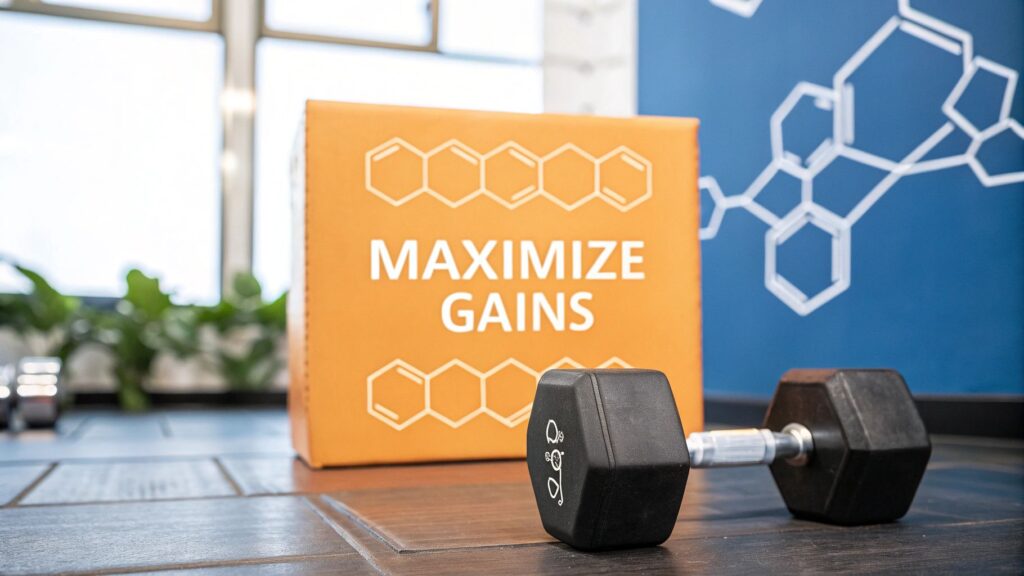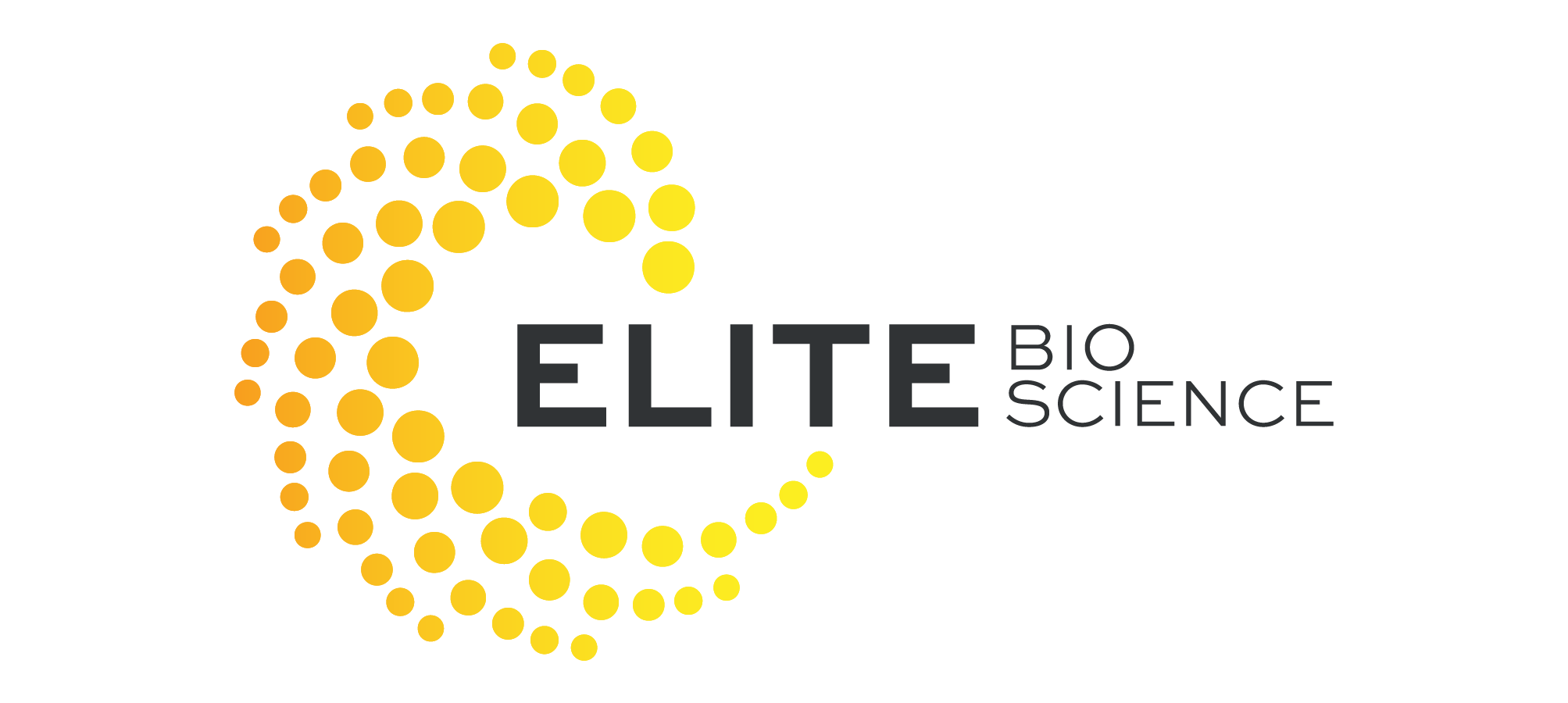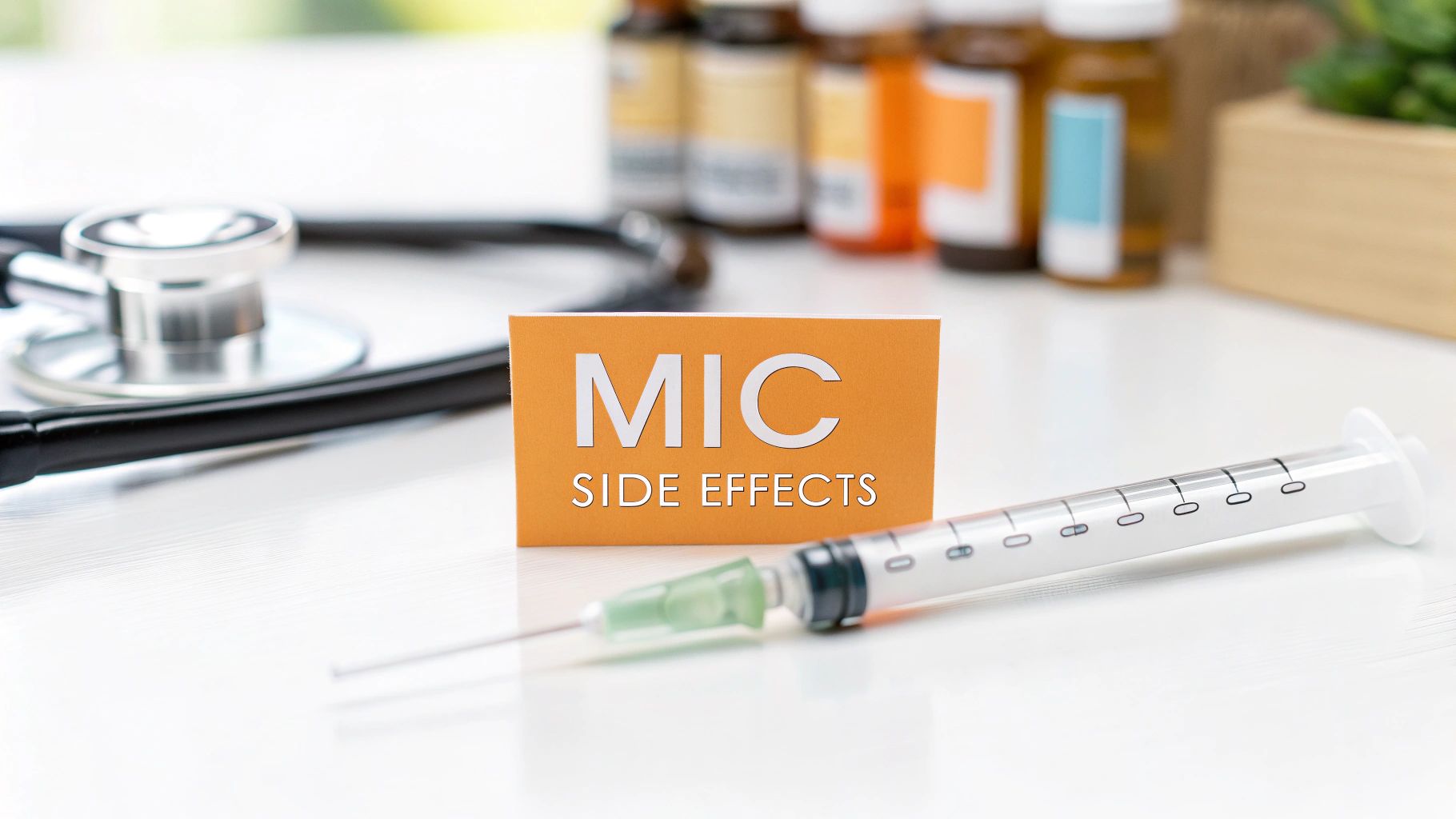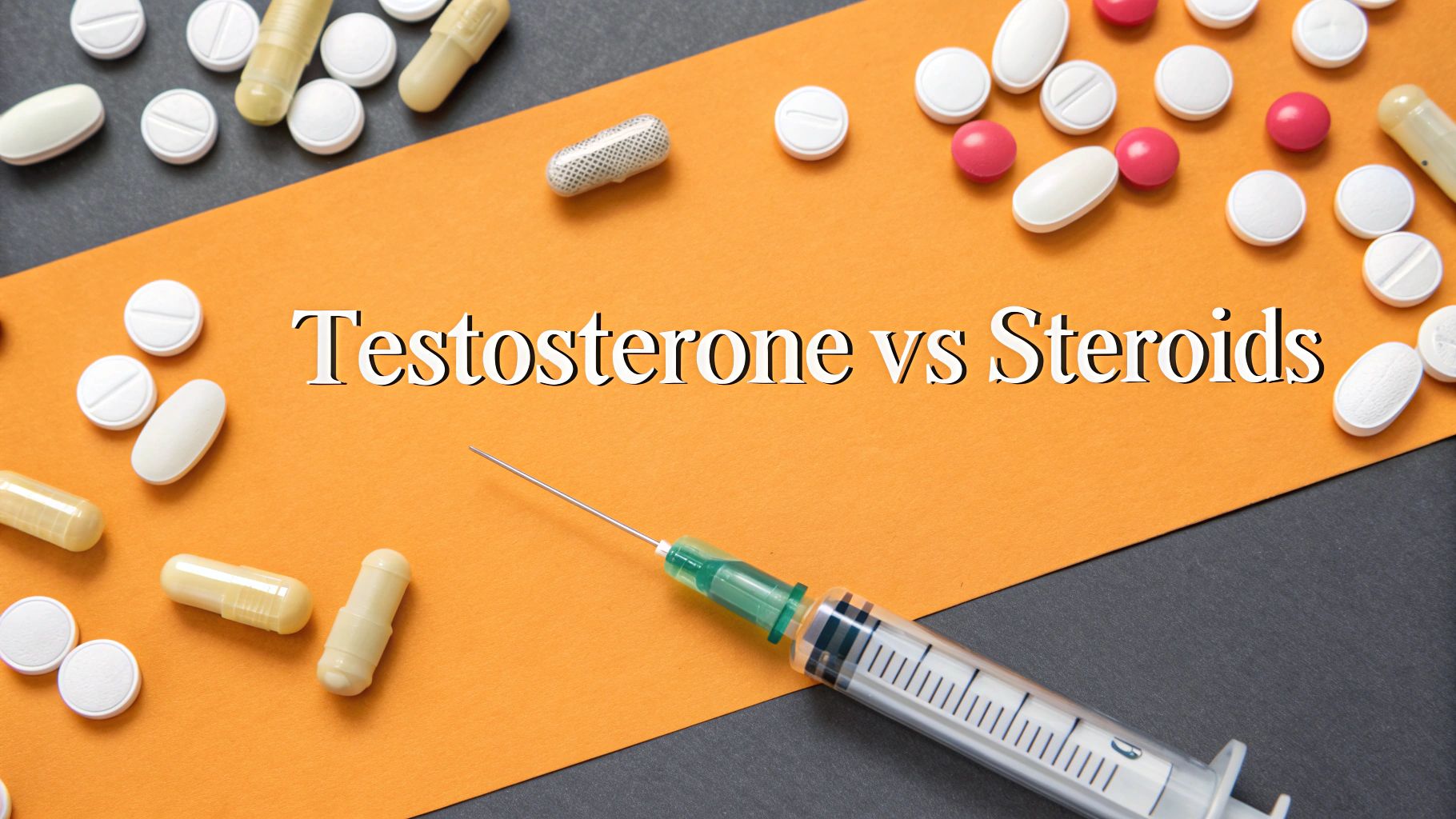Maximize Muscle Gain with Testosterone Replacement Therapy

Testosterone replacement therapy provides a direct route to serious muscle gain by putting your body's number one anabolic hormone back in the driver's seat. For men with clinically low testosterone, TRT can fire up muscle protein synthesis, slash recovery times, and build an internal environment primed for lean mass—often creating noticeable changes before you even ramp up your gym routine.
How TRT Actually Builds Muscle
To get a real sense of how testosterone replacement therapy drives muscle gain, picture testosterone as the master switch for your body’s muscle-building factory. When your levels are low, it’s like the factory is in a brownout—the most important machines are either off or just sputtering along. TRT flips that master switch back on, lighting up the whole production line and cranking it up to full capacity.
This isn’t just some vague feeling of being stronger; it’s a cascade of powerful biological events. Getting your testosterone back into a healthy range directly recharges the core processes behind muscle growth and repair, turning your body into a far more efficient anabolic machine. The infographic below breaks this down, showing how TRT elevates hormone levels to kickstart the whole process.

This visual shows the clear cause-and-effect: TRT raises testosterone, which then ramps up the all-important mechanism of muscle protein synthesis.
At its heart, testosterone is an anabolic hormone, which is just a scientific way of saying its job is to build things up—specifically, tissue. It does this through a few key biological actions that all work together to pack on muscle.
Let's break down the three primary ways TRT gets this done.
The Science of Anabolism
First and foremost, testosterone dramatically boosts muscle protein synthesis (MPS). Think of your muscles as brick walls and dietary protein as the bricks. MPS is the process of laying new bricks to repair damage from your workouts and build the wall bigger and stronger. Testosterone is the foreman on site, yelling at the crew to work faster, ensuring more protein "bricks" are laid down than are ever taken away.
This supercharged repair-and-grow cycle is the absolute cornerstone of the therapy. If you want to dive deeper into how this works, you can explore the relationship between TRT and muscle gain in our detailed guide.
Activating Muscle Stem Cells
Another potent effect of testosterone is its ability to wake up satellite cells. These are like dormant construction workers—muscle stem cells—that hang around your muscle fibers, just waiting for the call to action. When you lift weights, you create tiny micro-tears in your muscles, which is the signal they’ve been waiting for.
Testosterone is what makes that signal loud and clear. It tells these satellite cells to wake up, multiply, and fuse with the damaged muscle fibers. This not only patches up the damage but also adds new nuclei to the muscle cells, basically upgrading their capacity for future growth. It’s like adding more project managers to a job site, allowing you to build bigger, more complex structures down the line.
Improving Nitrogen Balance
Finally, testosterone helps your body hold onto nitrogen, putting you in a positive nitrogen balance. Nitrogen is a core component of amino acids, which are the building blocks of protein. For your muscles to grow, your body has to keep more nitrogen than it loses through natural processes.
A positive nitrogen balance is the quintessential anabolic state. It signifies that your body has sufficient raw materials to build and repair tissue, making muscle growth not just possible, but probable.
By improving nitrogen retention, TRT ensures your body is constantly in this prime muscle-building state. This biological shift makes every single workout more effective and every gram of protein you eat more productive.
The evidence for this is undeniable. To make it easier to see how these mechanisms work together, the table below summarizes their roles.
Key Mechanisms of TRT for Muscle Gain
Here's a quick summary of the primary biological actions testosterone takes to promote muscle growth.
| Mechanism | Simple Explanation | Impact on Muscle |
|---|---|---|
| Increased Muscle Protein Synthesis (MPS) | Tells your body to use dietary protein to repair and build muscle tissue much faster. | Accelerates muscle repair and growth after workouts, leading to faster size and strength gains. |
| Satellite Cell Activation | Wakes up dormant muscle stem cells to help repair damaged fibers and add new nuclei. | Increases the muscle's long-term potential for growth and improves recovery from intense training. |
| Positive Nitrogen Balance | Helps the body retain more nitrogen, a key component of protein, than it loses. | Creates the ideal anabolic (tissue-building) environment needed for consistent muscle growth. |
These interconnected actions create a powerful synergy for building lean mass.
Large-scale analyses show that TRT can lead to an average lean mass gain of 1.5 to 3.5 kilograms in just a few months, and that’s often without any dedicated exercise. It’s no surprise that when you combine it with proper resistance training, the results become even more profound. You can learn more about these impressive TRT and muscle gain findings and see the data for yourself.
What to Expect During Your TRT Journey
Starting testosterone replacement therapy for muscle gain isn't an overnight switch flip; it's a phased journey with distinct stages. Understanding this progression is key to setting realistic expectations and recognizing the signs that things are moving in the right direction.
Think of it less as a magic bullet and more as restoring your body's powerful anabolic environment. You're creating the perfect foundation for your training and nutrition to finally deliver the results they should.
In the beginning, you're likely to experience a rapid and encouraging boost. Many men report a noticeable lift in energy, motivation, and mental clarity within the first few weeks. This renewed drive often translates directly into better, more intense workouts, creating a positive feedback loop right from the start.
This early phase is also where you might see some quick changes in your strength and physique, though some of it can be a little misleading.

The Initial Surge and Adaptation
In the first month or two, your body is adapting to its new, optimized hormone levels. During this period, it’s common to notice:
- Increased Strength in the Gym: You may find yourself adding more weight to the bar sooner than you’d expect.
- Improved Recovery: Soreness might not linger as long, allowing you to train more frequently or with higher intensity.
- Water Retention: Some initial weight gain can be from increased water retention as your body adjusts, which can make muscles look fuller.
This initial surge is highly motivating and provides tangible proof that the therapy is working. But this rapid rate of change is temporary. Your body is recalibrating its internal systems, and what comes next is a period of more stable, consistent progress where your lifestyle habits become paramount.
Stabilization and True Muscle Accrual
After the initial adaptation period, usually around the three-month mark, your hormone levels start to stabilize. The dramatic week-to-week jumps in strength may level off, replaced by a more predictable and sustainable pace of muscle growth.
This is the phase where true lean tissue is built, and your success becomes deeply connected to your dedication in the gym and the kitchen.
This is also when consistent medical oversight is critical. Your healthcare provider will monitor your blood work to ensure your testosterone levels remain in the optimal range without causing unwanted side effects. To understand more about this crucial process, you can explore the details of why monitoring TRT is so important in our guide.
This stabilization phase is where the synergy between TRT and lifestyle truly shines. The therapy provides the anabolic potential, but consistent resistance training and proper protein intake are the actions that unlock it.
Research confirms this pattern of adaptation followed by sustained growth. A case study following individuals combining TRT with exercise for six months noted a substantial 10% increase in lean muscle mass and a 3% reduction in body fat.
The study highlighted an initial spike in hormone levels that later stabilized, yet muscle gain continued to climb, driven by the powerful combination of therapy and consistent training.
This phase-based progression underscores the importance of patience. The journey of testosterone replacement therapy muscle gain is a marathon, not a sprint, with each stage bringing its own unique changes and opportunities for growth.
Choosing the Right TRT Protocol for Your Goals
Not all testosterone replacement therapy is created equal, especially when building muscle is your top priority. Picking the right protocol isn't just a minor detail—it's a critical conversation to have with your doctor. The delivery system you choose has a direct impact on hormone stability, peak levels, and even how well it fits into your life, all of which shape the anabolic environment you're trying to create.
Think of it like fueling a high-performance engine. You could use a steady, consistent drip-feed or a more powerful, periodic blast of fuel. Both will get the engine running, but one is far better suited for maximizing horsepower. The same logic applies to TRT and packing on lean mass.
Your protocol has to line up with your specific testosterone replacement therapy muscle gain goals, your daily routine, and how your body uniquely responds. Getting familiar with the pros and cons of each method is the best way to have an informed discussion with your doctor and find the perfect fit.
Injections: The Gold Standard for Anabolism
When it comes to TRT, injections are one of the most common and effective methods out there. This involves injecting testosterone cypionate or enanthate directly into the muscle, usually on a weekly or bi-weekly schedule.
This route is incredibly popular for muscle building because it creates a predictable and powerful spike in testosterone levels right after the injection. That peak then gradually tapers off until your next dose. Some evidence suggests these temporary supraphysiological peaks send a potent anabolic signal, kicking muscle protein synthesis into overdrive.
- Pros: Highly effective, generally cost-efficient, and allows for precise dose adjustments based on your bloodwork.
- Cons: It involves needles, which isn't for everyone. The hormonal peaks and troughs can also cause mood swings for some people and require sticking to a consistent schedule.
For many guys, the direct, powerful effect of injections makes them the go-to choice for maximizing lean muscle.
Gels and Creams: Daily Stability
Topical gels and creams offer a non-invasive alternative. You apply them daily to the skin, typically on the shoulders or upper arms, where the testosterone is absorbed to provide a stable, consistent release of the hormone all day long.
This approach does a better job of mimicking the body’s natural daily rhythm than injections do, avoiding those sharp peaks and valleys. While that stability is fantastic for keeping your mood and energy levels even, it might not create the same intense anabolic spikes that injections are known for.
The key trade-off with topicals is peak anabolic potential versus hormonal consistency. Gels provide a steady state that supports growth, while injections create powerful, periodic surges that can be highly effective for muscle accrual.
A big drawback, however, is the risk of transference. The gel can easily rub off on partners, children, or pets, so you have to be extremely careful to prevent accidental exposure.
A Quick Comparison of TRT Methods
Choosing the right delivery method is a big deal when your primary goal is building muscle. Each option has its own set of advantages and potential headaches that can affect your results and daily life. The table below breaks down the most common methods to help you see how they stack up against each other specifically for muscle-building purposes.
Comparing TRT Delivery Methods for Muscle Gain
| Method | Pros for Muscle Gain | Cons to Consider | Typical Frequency |
|---|---|---|---|
| Injections | Creates powerful anabolic peaks that are great for muscle protein synthesis. Allows for very precise dosing and is cost-effective. | Requires needles. Can cause hormonal fluctuations (peaks and troughs) that may affect mood. | Weekly or Bi-weekly |
| Gels/Creams | Provides very stable, consistent daily hormone levels, which is good for steady growth and mood stability. Easy to apply. | May not create the same potent anabolic spikes as injections. High risk of transference to others through skin contact. | Daily |
| Patches | Offers a non-invasive daily dose with a steady release. | Often causes significant skin irritation. May not deliver enough testosterone for optimal muscle-building peaks. | Daily |
| Pellets | Extremely convenient, providing a "set it and forget it" stable hormone release for months. | Requires a minor surgical procedure for insertion. Dosing is less flexible and cannot be adjusted easily between insertions. | Every 3-6 Months |
This comparison makes it clear that there's no single "best" method for everyone. While injections are often favored for their potent anabolic effect, the consistency of gels or the convenience of pellets might be a better fit for your lifestyle. The key is to weigh these factors with your doctor to find the most sustainable and effective path forward.
Patches and Pellets: Less Common but Viable
Other delivery methods are out there, though they're often less common choices when the main goal is building serious muscle.
- Patches: You stick these on your skin daily, and they release testosterone slowly. The big downside? A significant number of men find they cause pretty bad skin irritation.
- Pellets: These are tiny, rice-sized pellets that a doctor surgically implants under your skin every three to six months. They offer a very stable, long-term release of testosterone but require a minor in-office procedure for both insertion and removal.
Ultimately, the best protocol is the one that's safe, effective, and sustainable for you. By discussing all these options with your physician, considering your lifestyle, and regularly monitoring your bloodwork, you’ll ensure your testosterone replacement therapy muscle gain journey is built on a solid foundation.
More Than Muscle: Improving Functional Strength
While the conversation around testosterone replacement therapy muscle gain often focuses on building a more impressive physique, the real value runs much deeper. It’s not just about looking stronger; it’s about being fundamentally more capable in your day-to-day life. This is where functional strength comes in—the kind of strength that directly improves your quality of life.
Optimizing your testosterone levels doesn't just increase the size of your muscles; it enhances their power and efficiency. Think of it like upgrading a car's engine. You don’t just get a bigger engine; you get one that’s more responsive, delivering better performance exactly when you need it. This translates into tangible, real-world benefits you can feel every single day.

From The Gym To Everyday Life
The strength you build in the gym is only useful if it serves you outside of it. Functional strength is the bridge between lifting weights and living a better life. For men on TRT, this bridge becomes stronger and more stable, making activities that may have become difficult feel manageable again.
This isn't just a small improvement; it's a profound shift in physical autonomy. Suddenly, tasks that felt like chores become easier.
- Carrying Groceries: A heavy load of groceries no longer feels like a struggle from the car to the kitchen.
- Climbing Stairs: Taking the stairs becomes less daunting, with more power in each step.
- Playing with Kids or Grandkids: You have the stamina and strength to keep up, lifting them without a second thought.
- Yard Work: Activities like hoisting bags of soil or pushing a lawnmower are far less taxing on your body.
These small victories add up, leading to a much greater sense of confidence and independence, especially as you get older.
The Science of Functional Improvement
So, how does TRT actually boost this practical, usable strength? The answer is in the difference between muscle mass and muscle power. While TRT is excellent at increasing lean body mass, its impact on muscle power—the ability to generate force quickly—is arguably more important for daily function.
Muscle power is what allows you to pop up from a chair without using your hands, catch yourself before a fall, or quickly lift a heavy box off the floor. As we age, muscle power declines much more rapidly than muscle strength, making it a critical marker of physical independence. TRT helps reverse this decline by improving neuromuscular efficiency, meaning your brain can activate your muscles more effectively and rapidly.
By restoring hormonal balance, TRT improves the entire system—from the neurological signals firing from your brain to the contractile force of your muscle fibers. This systemic upgrade is what translates into better balance, mobility, and overall functional performance.
This link between TRT and functional ability isn't just anecdotal; it's backed by solid research. For instance, a landmark 3-year trial following older men showed that TRT led to significant improvements in muscle power, strength, and lean body mass. While the absolute gains were modest, the resulting improvements in functional tasks like stair-climbing power were highly meaningful for maintaining daily activity levels. You can read more about these important findings on functional performance and their implications for aging populations.
Preserving Vitality and Independence
Ultimately, the goal of any health intervention should be to improve your quality of life. The journey of testosterone replacement therapy muscle gain is a powerful example of this principle in action. While the aesthetic benefits are certainly a welcome bonus, the ability to move through the world with strength, confidence, and ease is the real prize.
By enhancing functional strength, TRT becomes a crucial tool for preserving vitality and maintaining independence long-term. It empowers you to stay active, engaged, and self-sufficient, ensuring you can continue doing the things you love without physical limitations holding you back. This shift in focus from mere muscle size to genuine life enhancement is what makes TRT a truly valuable therapy for your well-being.
Maximizing Your Results with Training and Nutrition
Testosterone replacement therapy sets the perfect stage for building muscle, but let’s be clear: it doesn’t do the work for you. Think of TRT as upgrading your body’s construction crew, giving them top-of-the-line tools and a huge surge of motivation. But your training and nutrition? That’s the architectural blueprint and the raw materials. Without them, nothing gets built.
This therapy creates the ideal anabolic environment, but it's your lifestyle choices that truly cash in on that potential. A smart, integrated plan is the only way to squeeze every last drop of value out of your investment. To see the full range of positive changes possible, you can learn more about the benefits of TRT that go far beyond just muscle.

Building Your Training Blueprint
With optimized testosterone, your body can handle—and recover from—more intense training than ever before. This is your green light to finally embrace the most effective muscle-building strategies that might have felt too draining in the past. The key here is to work smarter, not just harder.
The foundation of any serious muscle-building program is resistance training. Your focus should be squarely on compound movements that hit multiple large muscle groups at once.
- Compound Lifts: Exercises like squats, deadlifts, bench presses, and overhead presses are completely non-negotiable. They stimulate the greatest amount of muscle mass and trigger a far more significant hormonal response.
- Progressive Overload: This is the golden rule of muscle growth, period. You have to consistently challenge your muscles by gradually increasing the weight, reps, or sets over time. If there’s no new challenge, your body has zero reason to adapt and grow.
Your supercharged recovery on TRT means you can hit the gym with real intensity more often. This accelerates the progressive overload process, leading to faster and much more noticeable gains.
Fueling the Machine with Smart Nutrition
Your diet is every bit as critical as your training. All that sweat and effort in the gym goes straight down the drain if your body doesn't have the building blocks it needs to repair and grow muscle tissue. Proper nutrition is the high-octane fuel for your newly tuned anabolic engine.
The single most important nutritional component for testosterone replacement therapy muscle gain is protein. Testosterone cranks up muscle protein synthesis, but that process is starved for resources without a steady supply of amino acids from the protein you eat.
Think of protein as the bricks and TRT as the master bricklayer. You can have the best worker on the planet, but if the truck never delivers any bricks, no wall is getting built. Your job is to keep the construction site fully stocked.
You should aim for a daily protein intake of around 1.6 to 2.2 grams per kilogram of body weight. Hitting this target ensures your muscles have a constant stream of the raw materials they need to grow.
Beyond protein, your total calorie intake is a huge factor. To build new muscle, you need to be in a slight caloric surplus, which just means you’re eating a bit more than your body burns each day. This provides the extra energy required to synthesize new tissue.
Focus on whole, nutrient-dense foods—lean meats, complex carbs, and healthy fats—to fuel your body properly and support your overall health. This powerful combination of targeted training and precise nutrition is what will turn your body's newfound potential into real, measurable results.
Your TRT and Muscle Questions, Answered
Even when you understand the science, you're bound to have practical questions about what to expect. Let's tackle some of the most common ones head-on so you can move forward with a clear picture.
How Fast Will I Actually See Muscle Gains on TRT?
While everyone's body responds a bit differently, most men start to feel stronger and more driven in the gym within the first month. As for visible changes, you’ll typically start noticing real muscle growth after about three to six months of consistent therapy. This, of course, assumes you're hitting the weights and eating right.
It's also common to see a bit of initial "fullness" in the muscles early on. That's often due to increased water retention, which happens before the slower, steadier process of building true lean tissue really kicks into high gear. The bottom line? Be patient. TRT opens the door, but you still have to do the work to walk through it.
Can I Build Muscle with TRT if I Don't Work Out?
Technically, yes, you can. Some studies show that men with low testosterone can gain a bit of lean mass from therapy alone because it flips the body's switch into a more anabolic, or muscle-building, state.
But let's be realistic. To achieve the kind of significant, noticeable testosterone replacement therapy muscle gain you're likely after, hitting the weights is non-negotiable. Think of TRT as loading the cannon; resistance training is what actually fires it. Skipping the gym means you're leaving the vast majority of your potential results on the table.
Does TRT Burn Body Fat, Too?
Absolutely. This is one of the biggest reasons men are so satisfied with their results. On top of helping you pack on muscle, getting your testosterone levels dialed in often sparks a noticeable drop in body fat.
Testosterone is a key player in regulating your metabolism and telling your body where to store fat. As your lean mass climbs, you'll likely find your body fat percentage going down, carving out a leaner, more athletic look. This powerful one-two punch on body composition is a hallmark of effective therapy.
Will TRT Shut Down My Natural Testosterone Production?
Yes, and this is a critical point to wrap your head around before starting. When you introduce testosterone from an outside source, your body's own production line shuts down. It's a simple feedback loop: your brain senses there's plenty of testosterone in the system, so it stops sending the signal to your testes to make more.
This is why TRT is generally considered a long-term commitment. If you stop therapy, your levels will plummet, and it can take your body a long time to restart its natural production—if it ever fully recovers at all. This is a serious conversation you need to have with your doctor from the very beginning.
Ready to explore how a personalized hormone optimization plan can help you finally achieve your strength and physique goals? The team at Elite Bioscience provides expert medical guidance and tailored treatment programs to help you optimize your health safely and effectively. Visit https://elitebioscience.co to learn more and start your confidential health assessment today.
QUICK SEARCH
Make an account today to start your journey towards a better and healthier lifestyle.






